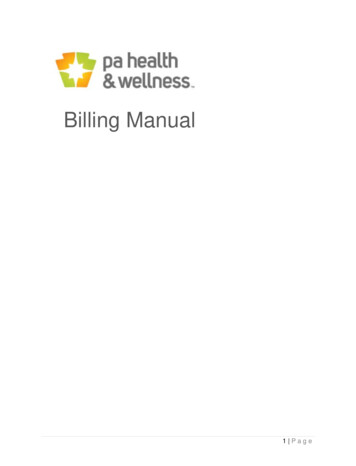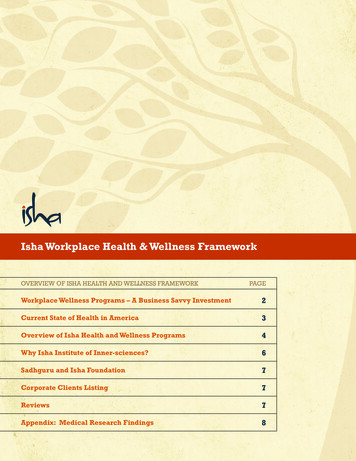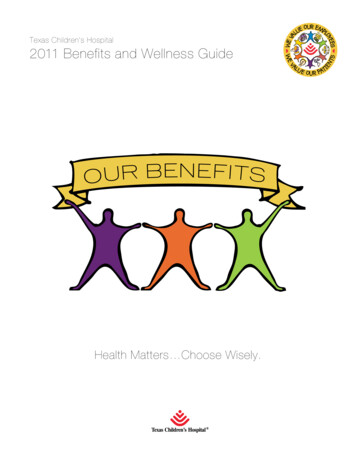
Transcription
Well@workWellness & HealthFair Planning GuideIn planning a health fair or other wellness event, remember rule number one PROMOTE, MOTIVATE, PROMOTE. Adapting a consistent theme for all promotionalmaterials will help promote and build awareness of your worksite wellness orhealth fair, and more importantly, motivate your audience to attend the event.Remember that different people respondto different messages, so use as manymethods as possible to promote an event.Think about how messages and memos arenormally communicated in your organization.If a certain method of communication thatworks well in your workplace, start there.Promote the event at least four weeks in advance.Consider using a different method or a variety ofmethods to communicate the event each week.Keep the messages simple and interesting byadding more information with each message(teasers). This can raise curiosity and anticipation.Don’t forget that word of mouth is often the bestmethod of communication. Therefore, you willwant each person on your planning team to talkup the event (in hallways, in elevators and atmeetings). This also works well on the day ofthe event. Before participants go back to theirworkstations, remind them to tell others aboutthe event and encourage them to attend.Here are some ideas to promote yourhealth fair. Remember to pick a variety ofmethods to help ensure a large turnout: Voicemail message reminders Table tents in break rooms and cafeteria E-mail messages An article in the company newsletter Banners Announcements at employee meetings Paycheck stuffers Word of mouth Flyers on everyone’s desk themorning of the event Intranet postings Flyers that offer an incentive toparticipate in the event Place posters in highly visiblelocations such as: On the door of the employee entrance In the copy room On restroom mirrors and theback of stall doors. Under the windshield wiper of eachemployee car in the parking lot In the elevators and/or staircasesmodahealth.com0268 (06/20)
Well@workThemes: Review your organization’s goals,corporate philosophy and culture to determinean appropriate theme for your health fair. Isyour organization competitive, conservative,formal, or fun? What are your organizationaldemographics – what age and sex is themajority of the employees? Use this informationto develop a theme for your health fair.Your health fair may be a kick-off another event,a new wellness program or an annual event.Consider the season of the year or National HealthObservances http://www.healthfinder.gov/nho/default.aspx (National Health Information Center).For example, February has Valentine’s Day andis National Heart Month. For a springtime healthfair, your theme might be “Spring into Health.”The best health fairs have a variety of activities.Awareness &educational informationAwareness & educational information shouldbe fun and interactive. Some ideas include: Self-care information Humor & its health benefits Back care Child safety Office safety Recycling Organic Produce Stress information Ergonomics Recreational safety Women’s/Men’s health issues Nutritional information Dental and oral health First aid and emergency preparedness Childcare resources Cancer & preventive exam schedules Substance abuse informationLifestyle informationand screeningsLifestyle information and screenings help buildawareness of health risks and provide informationon how an individual can make behavioralchanges to enhance his or her health. Whenconsidering screenings at a health fair, ensure theconfidentiality of the results. Most screenings takeseveral minutes so allow extra time for participantsto attend these booths, or allow participants topre-register for a specific time for screenings.Suggestions for screenings include the following: Blood pressure Body mass index (BMI) Bone density testing Health Risk Assessments Flexibility testing Glucose testing Mobile mammography Nutritional analysis Total cholesterol testing HearingDemonstrationsand activitiesDemonstrations and activities can add fun andinterest to your health fair. Hands-on learningcan enhance awareness. Some ideas include: Chair massages CPR Yoga Exercise equipment demonstrations Healthy cooking First aid Emergency Preparedness Ergonomics Martial arts Proper lifting Aerobic step demonstrations0268 (06/20)
Well@workWith any of these activities, ask if your vendorhas freebies. Freebies are great incentivesfor participants to come to your event!In planning a health fair, think about whatis available to you within your organization.Contact staff who may be affiliated withthe following departments to get ideas forhealth fair displays and information:Safety An accident prevention display Fire extinguisher demonstrations Carbon monoxide poisoning informationFood Service Free samples healthy foods Discounts on certain food itemsthe day of the health fair Food storage safety demonstration/educationTransportation Information and sign-ups forrideshare programs Safety belt and child safety demonstrations Bike helmet safetyEmployee Club Information and sign-ups for employeerecreational events such as softball,biking clubs, and bowling leaguesOccupational Health Blood pressure screenings First aid demonstrations Back care, ergonomics, properlifting informationCommunications and Marketing Get them involved in designing logosand materials for the health fair as wellas attractive signs and postersTravel Some organizations have traveldepartments that may be able toassist with raffling off a free trip to ahealth place or a weekend getaway! AAA – Roadside assistanceand travel planningLeverage External ResourcesThere are a wide variety of resources availableto your organization for a health fair. Externalresources can include community agencies,voluntary organizations, and for-profit andnon-profit organizations. When inviting theseorganizations to your health fair, provide themwith at least one-month notice. Health fairs area great marketing tool for outside vendors todisplay their products and services. However, beclear about what you expect from each vendor.Using outside vendors can make a health fair wellrounded and interesting as well as educational.Try not to duplicate services or displays. Thefollowing organizations may be able to provideservices, information, screening, and more atyour health fair. Don’t forget to be creative!Health PlanThe Moda Health Promotion & Wellness team maybe able to support your health fair event. Theymay be able to identify sources for interactivedisplays and materials on a variety of healthtopics to help your employees learn moreabout healthy lifestyles. We can also assist inarranging health screenings for your event.0268 (06/20)
Well@workEmployee Assistance Program (EAP)Government AgenciesHealth fairs are a great venue to showcaseyour EAP. This is a good reminder of theservices they provide to employees. Your EAPcan share the following at your health fair:Government agencies can provide information ona variety of topics, including recreational activities,in your organization’s geographical area: Information on the services available from the EAPSubstance abuse informationStress management informationVoluntary OrganizationsMany of the following community organizations canprovide educational and informational materials: HIV/AIDS organizations and education American Cancer Society American Diabetes Association American Heart Association American Lung Association March of Dimes Mothers Against Drunk Driving Habitat for HumanityProviders of Health Promotion ProgramsThere are many different providers of healthpromotion, prevention and educationavailable for health fair events: Chiropractic/podiatrist offices Massage therapists Exercise equipment specialists Sports equipment demonstrations First aid demonstrations Fitness Centers Your local hospital/clinic Boat and swimming safety Drinking and driving prevention/ substance abusePark and recreation informationPolice and fire safetyWildlife fish and game informationCommunity ResourcesA wide variety of resources are available inyour community. Some of these include: Restaurants/grocery stores for fooddemonstrations and samplings Childcare and eldercare agencies Food Co-ops for health food samples and recipes (Farmers markets)Community Education (Community College)Religious organizationsHealth fair organizers should take intoaccount not only mind and body, butthe spirituality of employees: Spiritual support/crisis-intervention organizations Community family support agencies0268 (06/20)
Well@workLocal Voluntary Organizations Raffles: Raffles can be a part of your vendors’display booths and demonstrations. Askvendors to participate when you contact them.Many of the following communityorganizations can provide educationalinformational material for your health fair:Each vendor can have their own raffle fortheir booth, encouraging a variety of prizesand giveaways. Prizes can be raffled offthroughout the day. Be sure to announcethe prizewinners to build excitement! American Cancer Societyhttp://www.cancer.org American Heart Associationhttp://www.americanheart.org American Lung Association http://www.lungusa.orgAmerican Red Crosshttp://www.redcross.orgMarch of Dimeshttp://www.marchofdimes.comMothers Against Drunk Drivinghttp://www.madd.orgCounty Health Division/ExtensionsCounty Sheriff’s DepartmentCounty ParkCreate SomePizzazzRaffles, prizes and giveaways can be funat a health fair. It helps build anticipation,participation and excitement. Incentives: You can use incentives toencourage people to participate andmotivate them to learn about healthyideas and lifestyles. Incentives thatsupport the theme of your health fair.Provide each participant with a trackingcard or “Wellness Passport” to be stampedby each booth/display he or she visits.After participants have visited a certainnumber of booths, they are eligible for afree gift or to enter a grand prize drawing.For each booth a participant visits, he orshe receives a token. The token can be arepresentation of your theme. The tokensare redeemed for a prize. To encourageattendance, leave half of a prize on employees’desks the morning of the health fair. They mustattend the health fair to receive the other half.A raffle can also be held at the end of theday. This allows each participant equalopportunity to win the prize. Decide whocan enter the drawing. It can be part ofthe registration process or can be builtinto the incentive as identified above.Logisticsare KeyWhen planning a health fair, consider the spaceyou have available. It is best to consider spaceavailability early so you will know how manyvendors and exhibits you can accommodate.A floor plan or layout will help determine thesetup and space needs. In designing the floorplan keep the following information in mind: Space: The space vendors will need mayvary. Let each vendor know in advance howmuch space they will have, or talk with eachvendor before designing the floor plan. Electricity: Check with each vendor todetermine if they will need electricityfor their booth or display. Locate theavailable electrical outlets and placethese vendors in your floor plan first. Screening Tests: If you have screening testssuch as blood pressure and cholesterol,place these vendors together. Also considerwhether one test needs to be performedbefore another. As screenings are consideredpersonal information, you may want toplace these vendors in a quiet area so thattest results can be discussed in private.0268 (06/20)
Well@work Traffic Flow: Some booths and displayareas are more popular than others andwill cause a line to form. If you anticipatethis, allow more space for these booths, orplace a less popular booth on either side.That way, people will visit the less popularbooths as they wait in line. Consider having anentrance and exit to ease the flow of traffic. Registration: Having participants registeris a great way to determine the numberof attendees at the health fair. Thisinformation can be used as part of yourhealth fair evaluation. You can go backto these participants for feedback. Vendor Information: To help the day runsmoothly, send a copy of the floor plan tovendors, letting them know where they will besetting up their booth. Also remind vendorswhere to park, which entrance to use to unloadtheir supplies and other relevant information. Wireless Internet: Confirm with vendorsFive to Six Months Prior: Get support from your organization’s leaders. Establish a champion within thesenior management team. Champion’s Name:Four Months Prior: Organize a Planning Committee. Yourplanning committee should range from threeto eight members. Clearly define tasks, withaccountabilities and agreed-upon time lines. Determine your target audience.Who do you plan to invite (Currentemployees, retirees, families)? Estimate number of employees youexpect to attend (25-50 percenttotal population on-site). Assess employee’s needs and interests. Top Interests:1.whether they need access to the internet.Have access information available.There will be changes at the last minute –so remember flexibility is important!Health fairs offer the opportunity to celebratehealth through the use of interactive displays,screenings, games, prizes, and other exhibits.Most importantly they demonstrate yourcommitment to the health and well-being ofyour employees. Use the following checklistto guide you in planning your health fair.2. 3.Establish goals and objectives thatcreate a clear direction for planningand executing your event. Use these asbenchmarks for evaluating event success. Establish your budget. Health fairs can berun on a shoestring if your primary goalis to increase awareness of local healthresources. If you intend to use the event asa kickoff for a new organizational programor part of a health screening initiative,you’ll need a significantly larger budget.If your budget is predetermined, then theplanning committee needs to prioritize themost important aspects of the event.0268 (06/20)
Well@workTypical budget items include: Site fees, equipment (i.e. DVDPlacer) or table rental Health screening services Vendors – some vendors charge to cometo a health fair; be sure to clarify Incentives – drawing for a largeincentive (value at least 50 - 100)typically creates more interest thansmaller items for each participant Healthy Food/Beverage – whileoptional, having snacks, fresh fruit,and other refreshments may helpdraw participants to your event Promotion – for advertising costs forbanners, signs, decorations, etc. Establish your theme. A theme creates yourpromotional campaign and helps focus thetype of exhibits, demonstrations, and activitiesyou plan to provide. Schedule it to coincidewith a National Health Observance (e.g.February is Heart Health Month; September isNational 5-A-Day Month, etc.). Be creative witha seasonal theme such as “Spring into Health”,“Fall into Fitness” or a fun theme like a “BeachParty”, “Wellness Rocks”, Sports themes,or tour themes (think “Healthy Journey”).Three Months Prior: Establish your implementation and evaluationplan. Evaluations are critical for measuringthe effectiveness of your health fair andhelping you plan future events. Processmeasures include tracking the number ofparticipants and surveying them about thecontent and quality of the event. Outcomemeasures include survey questions aboutwhat they learned and if they plan to makechanges based on their experience. Set date, time, and location. Athree-to four-hour time period isrecommended for most worksites. Develop promotional strategies.Maximizing participation is the nameof the game. Use your organization’scommunication channels to maximizevisibility, awareness, and interest in yourevent. Determine your top three strategies:1.2. 3.Identify program topics and preferred format(education, demonstrations, and/or activities).Identify your program resources. Beginwith organizational resources and thenmove to Moda and other organizationsuntil your programming needs are met.Contact Vendors. Create a listand assign committee membersto contact specific vendors.Two Months Prior: Arrange parking/security services. Contact and invite vendors. Allow plentyof time for gaining commitments. You mayneed to place follow-up calls if you don’tget a prompt response from key vendors.Ask for their equipment and special needs.Ask if they can donate any prizes. Determine the logistics of yourhealth screenings (pre-registration,# to schedule per hour). Design your floor plan. You need amplespace to accommodate participantsand vendors. Plan the layout to facilitateprogramming features such as screeningsand demonstrations. Consider the following: Amount of space a vendor needs (areaof 8 – 10 feet is usually adequate) Determine electrical and otheraudiovisual requirements Number of tables and chairs to have onhand for vendors and administrative needs Identify a welcome/registration area Consider traffic flow, screeningwaiting areas, and private places forhealth screening stations (ex. hearingscreenings need a quiet area) Identify demonstration/lecture areas0268 (06/20)
Well@workOne Month Prior: Promote your event. Promote all aspects ofthe health fair – such as examples of booths,refreshments and incentive items. Considerthe following ways to promote the event: Bulletin boards Corporate newsletter E-mail Posters in high traffic areas(common rooms, bathrooms, etc.) Table tents Flyers Department announcementsBegin taking pre-registrations forhealth screenings (if applicable).Arrange all food and prizes.Three Weeks Prior: Send confirmation letter to vendors, includingmap of your location, phone numbers,parkingand security information. Ask vendors to arrive60 minutes prior to the start of the event.Day of Heath Fair: Remind employees about today’sevent. Be sure to mention food,prizes or other funactivities. Greet vendors as they arrive - direct themto restrooms, health fair room, etc.After Heath Fair: Gather aggregate results from thehealth screening including the numberof participantsscreened, numberof high-risk individuals, etc. Review vendor and participant feedbackto determine the success of your event.Were thegoals and objectives achieved?Identify any changes or improvementsfor your next event. Keep a record ofeverything you did in planning your eventto guide your future health fair planning. Send thank you letters to all participatingvendors; include a summary of eventhighlightsand feedback as appropriate.One Week Prior: Re-confirm all services with vendors. Assign someone to greet anddirect vendors as they arrive. Review floor plan. Remind employees to preregister for screenings.0268 (06/20)
Well@workCongratulations for promotinga worksite health fair!The Wellness & Health Fair Planning Guide provides information for planning, implementing, andevaluating a health fair. It can assist employers and groups in conducting a successful worksite event.The possibilities for health fair activities are limitless. This guide provides basic suggestions; you maythink of others. You may also find that many modifications will be necessary for your health fair. The guidefurnishes you with ideas that you and your committee members may change to meet your needs.This guide is adapted from materials available from the Texas CooperativeExtension. Health Fair Planning Guide - Carol A. Rice, Ph.D., R.N., Professor &Extension Health Specialist, Texas A&M School of Rural Public Health.http://fcs.tamu.edu/HEALTH/health fair planning guide/index.phpIf you see or create other health fair activities that help people actively learn about wellnessand health, please send those ideas to wellnessadvisor@modahealth.com.modahealth.com0268 (06/20)
Food Co-ops for health food samples and recipes (Farmers markets) Community Education (Community College) Religious organizations Health fair organizers should take into account not only mind and body, but the spirituality of employees: Spiritual support/crisis-inter











